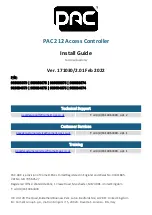
31
31-00083—02
CONTROL LOOP INPUTS
The control loop has seven control inputs plus four setpoint
override inputs, each has a specific purpose. Only the Main
Sensor is required for control loop operation. All other sensors
are optional depending on the application that the control loop
is configured for
ACCESSORY LOOP OUTPUTS:
OUTPUT OPERATION
A control loop calculates an output value of 0 to 100 percent
for each configured control loop output. Analog outputs will be
positioned proportionally to the output value based on the
output configuration. Staged outputs are configured with one
to three digital outputs. Minimum off and on times can be
configured and apply to all stages configured for the control
loop output.
Interstage on-off times can be configured and apply to all
stages configured for the control loop output. Interstage time
is the time lapse required before the next stage can be
switched on or off. The time should be set to match the
mechanical system response time.
Aux Output Operation; the Aux (auxiliary) Output is a digital
output that works like the fan output on a commercial
thermostat. The Aux output can be configured for either
continuous or intermittent operation. This selection applies to
occupied and standby operation. Unoccupied is always
intermittent. In continuous operation the output is on
continuously, regardless of the operation of the other control
loop outputs. In intermittent operation the output is on only
when an analog output value is greater than 0 or at least one
staged output is on. The Aux output can be configured with
minimum off and on times.
For a detailed description of the configurations available for
the accessory loops, refer to the descriptions for nciAcc1Pid
and nciAcc1SetPts.
The derivative control function opposes change. The greater
the proportional error the greater the braking effect of
derivative control. The derivative function is calculated by
subtracting the current proportional error value from the
proportional error value of the previous loop execution and
multiplying the result by the derivative time in seconds. The
derivative error is summed with the proportional and integral
errors to determine the loop output value.
In selecting the derivative time setting, the smaller the time
setting, the smaller the derivative effect and the greater the
time setting, the greater the derivative effect. A derivative time
of 0 (default) eliminates the derivative error. If using the
derivative time, it must be set to match the system response
time of the controlled equipment and significantly impacts the
throttling range and integral time settings. There are no
application specific settings for the derivative time as the
settings are unique to the equipment and load conditions.
EFFECTIVE SETPOINT
CALCULATION
EFFECTIVE SETPOINT
When working with control loops there is a distinction between
the program setpoints and the effective setpoint. The program
setpoints are the values entered into the controller program for
the occupied, standby and unoccupied setpoints for each
control loop that is configured. These values can be changed
at any time from an operator interface or the tool. These
setpoints are the initial values used in calculating the effective
setpoint. The effective setpoint is the actual setpoint value
used in a control loop to perform the PID calculations. It is the
result of programmed and calculated setpoint values that are
Input Name
Type
Description
Main Sensor
Analog
The input sensor is used in the PID loop to calculate the required
output positions. This is also referred to as the primary sensor.
This input must be configured to have a control loop that is
configured. If a fault (for example: open, short or loss of data)
occurs on the main sensor, the control loop stops and all outputs
are set to start value (usually 0) percent or off.
Reset Sensor
Analog
This sensor resets the occupied setpoint when the reset input is
configured. Refer to Setpoint
Reset for more information.
Occupancy Sensor
Digital
The occupancy sensor is used to determine the effective
setpoint
Loop Disable Input
Digital
This input disables the loop when the input is active (on, true).
The loop is enabled when the input is inactive (off, false).
Setpoint Input
Analog
Overrides the control loop calculated setpoint value when the
input is valid.
















































